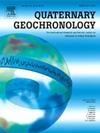Direct dating of marine sediments using optically stimulated luminescence techniques: Insights from ODP cores 658B and 659A
IF 2.5
2区 地球科学
Q3 GEOGRAPHY, PHYSICAL
引用次数: 0
Abstract
Luminescence dating of deep ocean sediments is hampered by disequilibrium in both the 238U and 235U decay series, leading to changes in environmental dose rate over time. This disequilibrium is caused by the incorporation of unsupported “excess” insoluble isotopes (230Th and 231Pa) and “authigenic” uranium isotopes without their decay products. Excess and authigenic isotope activity can be measured or modelled and used to determine dose rate evolution and estimate appropriate dose rates for age calculation. Comparison of measured and modelled data for two Ocean Drilling Program cores, 658B and 659A, implies that excess isotope activity needs to be measured. Calculated ages are relatively insensitive to small variations in authigenic isotope activity and this quantity can be modelled sufficiently accurately for age determination. Luminescence data for both cores are consistent with independent age models, though saturation of the quartz signal causes underestimates for some deeper samples.
使用光学激发发光技术的海洋沉积物直接测年:来自ODP岩心658B和659A的见解
深海沉积物的发光测年受到238U和235U衰变序列不平衡的影响,导致环境剂量率随时间的变化。这种不平衡是由不受支持的“过量”不溶性同位素(230Th和231Pa)和没有衰变产物的“自生”铀同位素的掺入引起的。过量和自生同位素活度可以测量或模拟,并用于确定剂量率演变和估计用于年龄计算的适当剂量率。对两个海洋钻探计划岩心658B和659A的实测数据和模拟数据的比较表明,需要测量多余的同位素活动。计算的年龄对自生同位素活度的微小变化相对不敏感,这个量可以足够精确地模拟用于年龄测定。两个岩心的发光数据与独立的年龄模型是一致的,尽管石英信号的饱和导致了一些更深的样品的低估。
本文章由计算机程序翻译,如有差异,请以英文原文为准。
求助全文
约1分钟内获得全文
求助全文
来源期刊

Quaternary Geochronology
地学-地球化学与地球物理
CiteScore
4.40
自引率
22.20%
发文量
130
审稿时长
20 weeks
期刊介绍:
Quaternary Geochronology is an international journal devoted to the publication of the highest-quality, peer-reviewed articles on all aspects of dating methods applicable to the Quaternary Period - the last 2.6 million years of Earth history. Reliable ages are fundamental to place changes in climates, landscapes, flora and fauna - including the evolution and ecological impact of humans - in their correct temporal sequence, and to understand the tempo and mode of geological and biological processes.
 求助内容:
求助内容: 应助结果提醒方式:
应助结果提醒方式:


